![[DOC Shield]](../gif/shld2.gif) |
Jefferson Market Jail
in the news again
and in a new book. |
 |
NEW $ TO RESTORE JEFFERSON Mkt. LANDMARK
BUILDING ONCE PART OF COURT-JAIL COMPLEX
City Council Press Release
Tuesday, August 21, 2007
MANHATTAN – Speaker Christine Quinn today joined State Senator Tom Duane, New York
Public Libraries (NYPL) President Paul LeClerc, and community leaders to announce new
funding to restore and rehabilitate the historic Jefferson Market Branch Library.
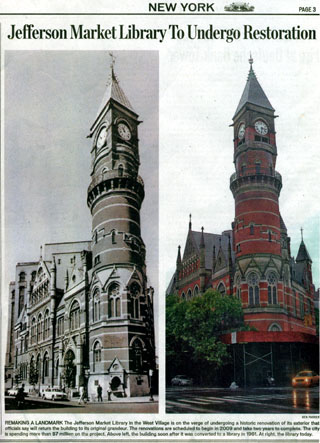 | | The landmark tower that once was part of the Jefferson Market Jail/Court Complex was featured in the above images on Page 3 of The New York Sun August 22, 2007 with the following caption:
"REMAKING A LANDMARK The Jefferson Market Library in the West Village is on the verge of undergoing a historic renovation of its exterior that officials say will return the building to its original grandeur. The renovations are scheduled to begin in 2009 and take two years to complete. The city is spending more than $7 million on the project. Above left, the building soon after it was converted to a library in 1961. At right, the library today."
Click image to access The New York Sun home page.
NYCHS appreciates receiving The New York Sun permission to post the above images and caption on our web site. The New York Sun retains the copyright and reserves all its rights thereunder. ©
| |
The funds will
be used for the renovation of the Library’s exterior, including work on the façade, windows, roof
and tower to remove hazardous conditions and assure the building’s structural integrity.
“With this investment in Jefferson Market Library, we are not only making needed renovations
to a historic building integral to the character of the West Village - we are also keeping doors of
opportunity open to New Yorkers,” said Speaker Quinn.
“The programs offered by our public
libraries help people further their careers and enrich their lives. We cannot allow Jefferson
Market Library to further deteriorate when New Yorkers have so much invested in this unique
and essential resource. I want to thank the Mayor, State Senator Tom Duane, and everyone else
that has made the preservation of this building and the expansion of library service city-wide a
priority.”
In February 2007, LI/Saltzman Architects completed a report, funded by Speaker Quinn and
Senator (and former Council Member) Duane, concluding that there was significant deterioration
of the building’s sandstone and brickwork. Because of this deterioration, along with open mortar
joints and cracked stone, water had penetrated the façade, causing movement and settlement of
the building’s stonework and rusting of the building’s iron structure.
The corrosion of the iron framework and cracks throughout the stonework has caused pieces of
sandstone to become loose and unsafe, necessitating a sidewalk bridge that has been in place for
four years. In addition, the entrance portico (located on 6th Ave) has detached from the building
and is leaning slightly toward the street.
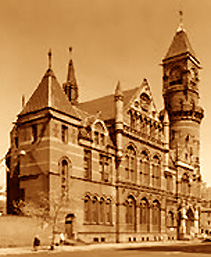 |
| Above is an image based on one appearing on a NY Public Library web site page with text entitled A History of the Jefferson Market Library. Below in this caption are excerpts from that history written in 2003 by
Frank Collerius, branch librarian, Jefferson Market Regional Library:
"It was erected (along with an adjacent prison and market) during the years 1875-1877 and cost the city almost $360,000. . . it was a civil court (on the second floor, where the Adult Reading Room is now) and a police court (now the first-floor Children's Room). The beautiful brick-arched basement (now the Reference Room) was used as a holding area for prisoners on their way to jail or trial. . . .
"By 1927 the courts were used solely for the trials of women, and in 1929 the market and co-ed prison were torn down and replaced by the Women's House of Detention, probably the only Art Deco prison in the world. Mae West was tried here soon after on obscenity charges when her Broadway play Sex became a target of the Society for the Suppression of Vice. West received a $500 fine, one day next door in the Women's House of Detention and nine days at the workhouse on Welfare Island (now Roosevelt Island). The House of Detention was razed in 1973 and replaced by a lovely community garden."
Click image to access NYPL's History of Jefferson Market Library page.
|
|
The funding will go to not only correct these issues and
return the façade to its original splendor, but also to shore up the previous deficiencies that led to
the original deterioration.
“I am thrilled that the City Council and the Mayor have provided additional funds beyond
those that I and Speaker Quinn secured as successive Council Members from District Three, so
that this landmark Library can be structurally restored and serve our community for years and
years to come,” said State Senator Tom Duane.
“With the funding finally secured, and the
building's safety and preservation concerns addressed, we can begin to move forward, with the
community, in pushing for a historic building that is accessible to all of its users.”
“For generations, the firewatcher's tower soaring over Sixth Avenue has fueled the literary
imaginations of children and adults alike,” Manhattan Borough President Scott M. Stringer said.
“This library is like something you'd expect to find at Hogwarts - yet it's right here in that most
magical of all lands - Greenwich Village. “Thanks to the Speaker and to the Mayor for making
sure future New Yorkers will be able to spin their own tales about this magnificent gothic tower
and the Victorian treasure down below.”
Speaker Quinn has allocated $2.7 million dollars to these renovations, having already allocated
$1.39 million in previous years. The Mayor's office has provided matching funds in the amount
of $2.2 million. In addition, Senator Duane had previously allotted over $700,000 to the project
when he was a Council Member, bringing the Jefferson Market Library's total capital funding to
over $7 million.
The Jefferson Market Branch Library is one of the great architectural wonders of the NYPL
system, and is an important location in the history of the West Village. Designed by Frederick
Clark Withers and Calvert Vaux, it was erected between 1875-1877 and initially served as a
courthouse.
By 1927 the building no longer served as a courthouse, and traded hands amongst various
agencies.
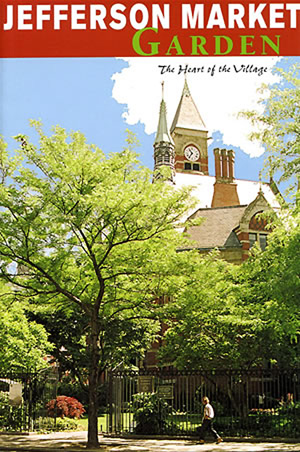 | |
Above is an image of the front cover of a Partnerships for Parks brochure about the Jefferson Market Garden, including the location's history. Below are excerpts from the text of NYC Parks & Recreation history sign at the garden and on the agency's web site:
Where some went to market, and some went to jail, today’s Greenwich Villagers tend the Jefferson Market Garden in the shade of the landmark Jefferson Market Courthouse [turned Library].
Named for Thomas Jefferson, third president of the United States, the Jefferson Market opened on this site in 1833, alongside a police court, a volunteer firehouse, and a jail. The market grew rapidly to include fishmongers, poultry vendors, and hucksters. It was razed in 1873 to make way for a new civic complex and courthouse.
The Jefferson Market Courthouse, with its fire-watch bell tower, and lighted clock dial, was designed by Frederick Clarke Withers and Calvert Vaux, and built in 1877. . . . While Vaux believed that the cells should be “strong, secure, and entirely unattractive,” he created a six-tiered structure that allowed some light to penetrate and air to circulate. . . .
In 1927 the jail, the market, and the firehouse were demolished and replaced by the City’s only House of Detention for Women, an 11-story building designed in the French Art Deco style by Benjamin W. Levitan. . . .
Amendments to the district court system in 1945 led to the abandonment of the courthouse, which was to be sold by auction in 1959. The Greenwich Village Association (GVA) . . . won their first victory in 1961 by saving the four-sided clock in the tower. A year later Mayor Wagner agreed to establish a . . . branch of the New York Public Library in the Jefferson Market Courthouse.
The Board of Estimate transferred the site to Parks in 1974, and the Jefferson Market Garden Committee, Inc., composed of Village neighborhood associations and homeowners, was entrusted with its care. . . .
In the late 1960s, GVA and Community Board 2 held town meetings to discuss the removal of the Women’s House of Detention and the creation of a “passive recreation area” on the site. At the time, friends and families of inmates lingered outside the House at all hours of the day or night, yelling their news and greetings. Nearby residents were disturbed by the noise. Gawkers came to watch the scene. The facility was overcrowded and had become obsolete. The Women’s House of Detention was demolished in 1973, after 42 years of use.
Click the above image to access the Partnerships for Parks brochure about the Jefferson Market Garden.
NYCHS appreciates receiving Partnerships for Parks permission to post the above brochure image on our web site. Partnerships for Parks retains and reserves all related rights. ©
| | It was used for some time as a Women’s House of Detention, and later by the Police
Academy. In 1958 the building, by then abandoned, was slated for demolition until area
residents (including E.E. Cummings and the actor Maurice Evans) rallied for its preservation. In
1961 Mayor Robert F. Wagner declared the building would be converted to its present use.
“The Library is tremendously grateful to Speaker Quinn, Senator Duane and Mayor Bloomberg
for the support that will enable us to bring this National Historic Landmark back to its original
grandeur,” said Paul LeClerc, President of The New York Public Library.
“The Jefferson Market Library is probably the most beloved and iconic building in the entire
Village,” said Brad Hoylman, the Chair of Community Board 2 in Manhattan.
“On behalf of the
board, I'd like to express my gratitude to Speaker Quinn and the City Council for providing the
funds to return the library to its former architectural glory, as well as strengthening its role as a
resource for Villagers by increasing the library's operating hours from five to six days a week.”
This year Speaker Quinn and the City Council were also able to secure $320 million in funding
for the City’s three library systems to provide for six-day library service throughout the five
boroughs' grandeur,” said Paul LeClerc, President of The New York Public Library.
In extending the hours of operation, libraries are able to increase access to vital
services like improving literacy programs, providing career development, and increasing access
to technology.
*** *** ***
JEFFERSON Mkt. JAIL/COURT COMPLEX IN NEW BOOK ABOUT Lt. BECKER CASE
A less laudatory description of the Jefferson Market Court/Jail complex appears in the first chapter of Mike Dash's new non-fiction book "Satan's Circus" about the case of NYPD Lt. Charles Becker, the only policeman ever executed for murder in the U.S. He was held in the Tombs during his two trials.
The court/jail complex was the setting for the dramatic September 1896 confrontation between The Red Badge of Courage author Stephen Crane, then a reporter with William Randolph Hearst's New York Journal, and Becker, then a patrolman still learning how to use his law officer position for corrupt gain. Crane's testimony resulted in a young woman Becker had arrested being freed. Here is the relevant excerpt from pages 11 and 12:
Jefferson Market Police Court, where [Patrolman Charles] Becker’s prisoner [Ruby Young] was brought
shortly before noon, was a scowling Gothic monstrosity that loomed
over a corner on Tenth Street and Sixth Avenue, its ornate redbrick
facade making it look more like a place of worship than a court of law.
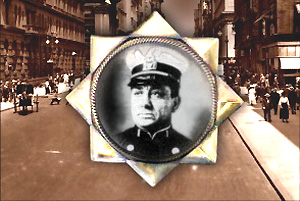 | |
Above: The front cover of Mike Dash's Satan's Circus features a portrait of Lt. Charles Becker against a background of a mid-Manhattan street in the era when road traffic consisted of both horse-drawn carriages and early model automobiles.
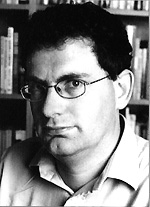 Mike Dash, right, author of Tulipomania and Batavia’s Graveyard, has studied history at the University of Cambridge and worked as a magazine publisher. He lives with his wife and daughter in London, researches in the British Library and writes for the English press. Mike Dash, right, author of Tulipomania and Batavia’s Graveyard, has studied history at the University of Cambridge and worked as a magazine publisher. He lives with his wife and daughter in London, researches in the British Library and writes for the English press.
Click the book cover detail image to access the book's page on the web site of Crown Publishing, a Random House publishing group. Click Mike Dash's image to access the book's page on the web site of Mike Dash.
NYCHS appreciates receiving Crown Publishing (a Random House publishing group) permission to post the above images on our web site. Crown Publishing (a Random House publishing group) retains and reserves all related rights. ©
| | “The windows,” [Stephen] Crane wrote in his own description of the place, "were high and saintly, of the shape that is found in churches.
"From time to time a policeman at the door spoke sharply to
some incoming person. 'Take your hat off!'
He displayed in
his voice the horror of a priest when the sanctity of the chapel
is defied or forgotten."
The Market’s magistrates processed an endless parade of drunks,
streetwalkers, delinquent saloonkeepers, and petty thieves with
mechanical efficiency, devoting just a few minutes to each case. Most
of the infractions they dealt with were minor and were punished with
small fines. The more persistent offenders might receive sentences of
a few days in the cells.
By the time Young was called to the bar, the courthouse was
crowded, as it was every day, with a throng of clerks, policemen, witnesses, and gawking spectators, many of whom had turned attendance
at the Market into a sort of hobby.
The latter were, Crane had once
noted with a frisson of disgust, "mere parasites who wore an air of
being in wait for a cry of anguish, some loud painful protestation that
would bring the proper thrill to their jaded, world-weary nerves.”
When, at the end of an earlier hearing, a young servant girl was sent to
jail for theft and let out a howl of anguish, “the loungers, many of
them, underwent a spasmodic movement as if they had been knived.”
In ordinary circumstances Young’s hearing would soon have been
over.
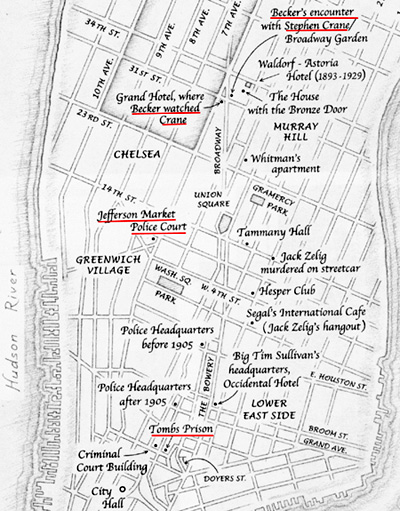 | | Above: A section from one of the two Manhattan maps in Mike Dash's Satan's Circus. Note that the NYCHS webmaster has digitally added red underlines to certain locations in the map for emphasis purposes related to subject matters of the web page you are currently viewing: the Jefferson Market court-jail complex, the Tombs, and the Stephen Crane/Ptl. Charles Becker encounter.
Click image to access the book's page on the web site of Crown Publishing, a Random House publishing group.
NYCHS appreciates receiving Crown Publishing (a Random House publishing group) permission to post the above map detail image on our web site. Crown Publishing (a Random House publishing group) retains and reserves all related rights.©
| | Women picked up for soliciting in Satan’s Circus had almost no
chance of mounting a defense, and the word of a policeman was always
preferred to theirs. Still, Ruby had done what she could with her
appearance.
Despite her long night in the cells, the auburn hair that
made her so recognizable had been pinned up and artfully arranged,
and although she had slept in the clothes she had worn the previous
night, one of the reporters in the courthouse wrote that she “certainly
did not look dissipated and was very neatly and prettily dressed.”
The
girl sobbed violently, and not entirely for effect, as she was led forward, and stood before Magistrate Robert C. Cornell “flushed and
downcast while a charge of soliciting was read against her.
Becker gave his evidence first. Clad now in his patrolman s uniform, with its thick blue jacket and large shiny buttons fastened up to
the neck, he seemed a much more imposing figure than he had in
plainclothes hours earlier. He was strongly built, with a bulky body that
was mostly muscle, large hands, broad shoulders, and an impressive
chest. A billy club and a service—issue Colt revolver protruded from his
belt, and he carried his tall white helmet tucked under one arm.
For more about the book, visit its page on the web site of Crown Publishing.
or on the web site of Mike Dash.Return to top of this web page.
|
![[DOC Shield]](../gif/shld2.gif)






